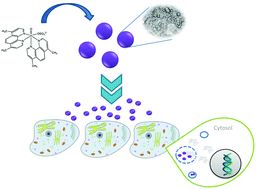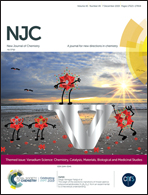Lipid nanoparticles – Metvan: revealing a novel way to deliver a vanadium compound to bone cancer cells†
Abstract
Cancer is one of the main causes of mortality worldwide. Common therapy schemes are always based on chemotherapy, radiotherapy and/or surgery. Among chemotherapeutics, vanadium compounds have recently emerged as non-platinum antitumor agents. In this sense, Metvan ([VIVO(Me2phen)2(SO4)]) was identified as one of the most promising vanadium anticancer complexes. In this work, the Metvan compound was encapsulated into well designed and developed nanostructured lipid carriers (NLCs) with the aim of improving its biopharmaceutical profile with regards to bioavailability, degradation, solubility and cell up-take. A quality by design approach was followed to find the optimal nanoparticle formulation for Metvan delivery. Results exhibited that the ideal formulation was obtained by using myristyl myristate as the lipid matrix and Pluronic F128 as the stabilizing agent with a mean nanoparticle size of 230.8 ± 3.1 nm and a mean surface charge of −7.9 ± 0.8 mV. The formulation showed an encapsulation efficiency of approximately 80% with a sustained drug release for more than 60 h. The kinetic release mechanism of Metvan from the nanoparticles fitted the Korsmeyer–Peppas model, indicating the Fickian diffusion of Metvan from the nanoparticles. On the other hand, the results showed that the nanoparticle-Metvan system is more effective to decrease cell viability on human osteosarcoma cells (MG-63) compared to the free drug, suggesting a possible different cell internalization mechanism and intracellular effect.

- This article is part of the themed collection: Vanadium Science: Chemistry, Catalysis, Materials, Biological and Medicinal Studies


 Please wait while we load your content...
Please wait while we load your content...